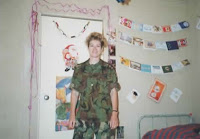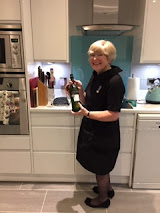Operation Driver was a, now rather forgotten, deployment to Kuwait in response to Iraq’s movement of troops south towards Kuwait’s border in October 1994.
I was Matron of 22 Field Hospital from 1993-95 and had never deployed on operations before, except to Northern Ireland in 1982. The unit was tasked to provide a Medical Support Troop (MST) in support of 45 Commando (Cdo) Group (Gp) Royal Marines (RM) with 72 hrs notice to move. The unit of 25 personnel was to provide a field hospital of 25 beds and an operating facility. Normally the Matron would not have deployed with a unit of this size but I was keen to go and the Commanding Officer (CO) was eventually persuaded.
The equipment required to build a hospital under canvas and its personnel were rapidly prepared and we travelled via Cyprus to Kuwait on 15 October by Hercules aircraft.
Our initial accommodation with the rapidly growing 45 Cdo Gp was in Al-Jahra Camp which was a Kuwaiti Army Camp, badly damaged during the war in 1991 and not repaired. Living accommodation was in leaking buildings or under canvas and yes, it does rain in Kuwait in October, as I found to my cost.
After a couple of days sanitary facilities in the camp were stretched to the limit and as temperatures reached 38 degrees centigrade during the day, it was vital that a suitable location for the MST was a priority.
The OC and I visited the Kuwaiti Military Hospital but despite much courtesy received no assistance. We finally negotiated generous facilities at Al-Jahra Hospital. This was a civilian 500 bed hospital in the working class town of Al-Jahra to the west of Kuwait City and was tactically in a good location for the defence of Kuwait from the north. They had already closed 150 beds in preparation for a possible conflict and were able to offer the MST a ward as well as staff accommodation. Other facilities which required separate negotiations were X-Ray, Physiotherapy, Theatre time and Pharmacy.
Fortunately, the tense political situation was soon diffused as Iraq moved its troops north again, and until we were able to return home, we offered hospital facilities to US, Kuwaiti and British soldiers.
The staff of the MST comprised a Field Surgical Team, 5 Registered Nurses, 9 Combat Medical Technicians, an Environmental Health Technician, Medical Supply Technician and a Driver, all organised by an administrative SNCO.
Acclimatisation did not take long and casualties were few. The Kuwaiti soldiers who were referred to us provided a challenge as far as language and culture were concerned. Most were wary of us at first but soon settled and proved to be generous and charming. Their visitors brought in jugs of sweet tea, which they offered us and huge boxes of chocolates which might have explained a high incidence of type 2 diabetes. The language problem was overcome by the presence of a local nurse on duty with us. The majority of the nurses in the hospital were Filipino, Bangladeshi or Egyptian, closely monitored by departmental Matrons, the Director of Nursing, who was very wary of us, and her assistants. My role was to lead the nursing staff on the ward rather than use my clinical specialty in theatre.
Theatre time was generously given when required and it was interesting to note that the set up was similar to what we were used to. The hospital administration system was frustrating to use and although we used our own field medical documentation we were also forced to use their system as well.
Their working day was from 0700 hrs to 1400 hrs so non-urgent investigations could not take place outside these hours.
We were well cared for by the Hospital Administrator, a charming man who ensured we were well fed although the diet of chicken and rice did begin to pall after a few weeks. We did PT five times a week in the early morning. Females had to do it early anyhow so as not to upset local sensitivities but that was acceptable as it was too hot later in the day.
As the threat diminished, opportunities for R and R arose. Invitations were received from various expatriate quarters, who were very grateful for our being there. We were able to use sports facilities in two hotels and the US Army recreation centre at Doha Camp.
President Clinton visited in mid November, after which it became evident that all troops would be home by Christmas. Working within a civilian hospital and treating Kuwaiti soldiers, we had a unique opportunity to experience at first hand another culture and realised very quickly how different and at times how difficult it is to understand.
I was nominated second in command as I was the only officer from the permanent staff of 22 Field Hospital and, depending on my duties on the ward, often attended daily briefings given at the HQ 45 Cdo Gp so learnt a lot in that respect but above all I was very grateful to have been given the opportunity to join a deployment which I would not normally have done.





















































